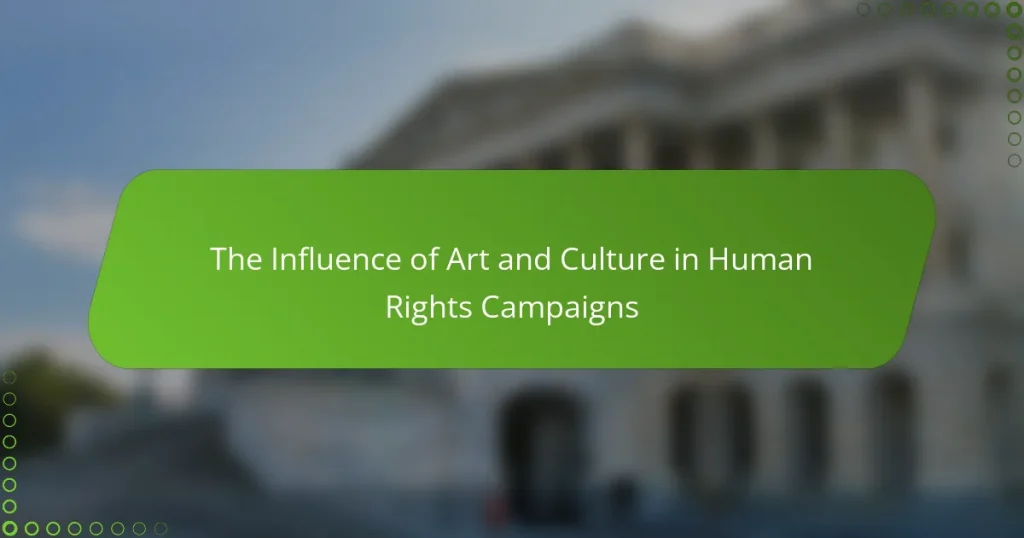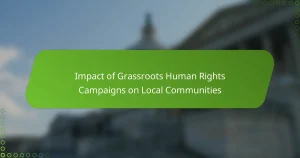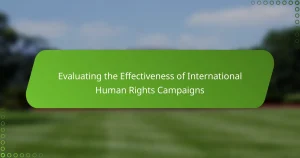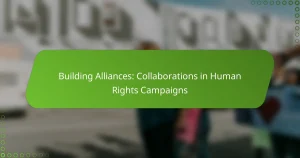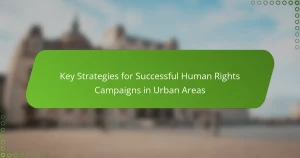Art and culture play a crucial role in human rights campaigns by shaping public perception and mobilizing support through various forms of artistic expression, including music, literature, visual arts, and performance art. These mediums convey powerful messages about social justice and evoke emotional responses that foster empathy and awareness. Historical and contemporary examples, such as Picasso’s “Guernica” and the “AIDS Memorial Quilt,” illustrate how art can effectively communicate human rights issues and inspire action. Campaigns that integrate art demonstrate higher engagement rates and can reach diverse demographics, highlighting the importance of cultural narratives in contextualizing human rights within local traditions and histories.
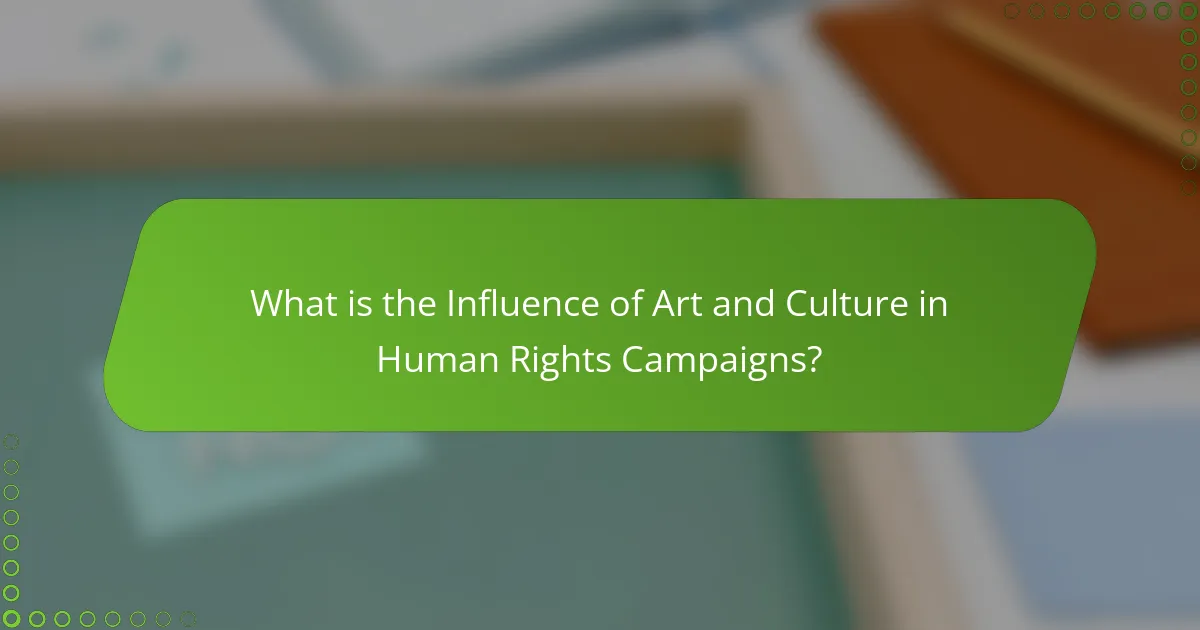
What is the Influence of Art and Culture in Human Rights Campaigns?
Art and culture significantly influence human rights campaigns by shaping public perception and mobilizing support. Artistic expressions, such as music, literature, and visual arts, can convey powerful messages about social justice. They often evoke emotional responses that resonate with audiences, fostering empathy and awareness. Cultural narratives help contextualize human rights issues within local traditions and histories. For instance, the use of street art has been pivotal in movements like Black Lives Matter, transforming public spaces into platforms for activism. Historical examples include Picasso’s “Guernica,” which highlighted the atrocities of war and human suffering. Research shows that campaigns integrating art have higher engagement rates and can reach diverse demographics effectively. Thus, art and culture not only raise awareness but also inspire action in human rights advocacy.
How do art and culture intersect with human rights advocacy?
Art and culture play a crucial role in human rights advocacy by raising awareness and fostering empathy. Artistic expressions, such as visual art, music, and literature, often highlight social injustices. They can evoke emotional responses that motivate individuals to take action. Cultural narratives provide context and understanding of human rights issues. For example, the “Art for Amnesty” campaign uses art to amplify voices of the oppressed. Historical movements, like the civil rights movement, utilized music and art to inspire change. These cultural tools can mobilize communities and influence public opinion. Thus, art and culture serve as powerful mediums for promoting human rights.
What roles do artists play in promoting human rights awareness?
Artists play a significant role in promoting human rights awareness. They use various forms of expression, such as visual art, music, and performance, to convey messages about social justice. Through their work, artists can highlight injustices and inspire action. For example, visual artists like Ai Weiwei have created pieces that draw attention to issues like refugee rights. Musicians often write songs that resonate with movements for equality and freedom. Documentaries and films produced by artists can educate audiences about human rights violations. Art festivals and exhibitions frequently serve as platforms for discussions on human rights. By engaging the public emotionally, artists can foster empathy and understanding. Their creative contributions often amplify the voices of marginalized communities.
How does cultural expression shape public perception of human rights issues?
Cultural expression significantly shapes public perception of human rights issues. It conveys narratives that resonate emotionally with audiences. Art, music, and literature often highlight injustices and human experiences. These mediums can humanize abstract concepts, making them relatable to individuals. For instance, the song “Imagine” by John Lennon promotes peace and unity, influencing perceptions of global human rights. Visual art, such as Picasso’s “Guernica,” depicts the horrors of war and its impact on civilians, raising awareness. Cultural expressions can mobilize communities, fostering solidarity and activism. They also serve as tools for education, informing the public about rights violations. Overall, cultural expression plays a crucial role in shaping attitudes and driving social change regarding human rights.
Why is the integration of art and culture important in human rights campaigns?
The integration of art and culture is important in human rights campaigns because it enhances emotional engagement and awareness. Art can communicate complex human rights issues in relatable ways. Cultural expressions resonate with diverse audiences, fostering empathy and understanding. Historical examples show that art has successfully mobilized support for various causes. For instance, the “I Am a Man” posters during the Civil Rights Movement galvanized public sentiment. Additionally, music and performance art can amplify marginalized voices, making their stories heard. Research indicates that culturally relevant messaging increases campaign effectiveness. Overall, art and culture serve as powerful tools for advocacy and education in human rights efforts.
What emotional impact does art have on human rights messaging?
Art evokes strong emotional responses that enhance human rights messaging. It can inspire empathy, provoke thought, and mobilize action. Visual art, music, and performance can illustrate the struggles faced by marginalized groups. For example, the use of powerful imagery in protests has historically galvanized public support. Art can also humanize abstract issues, making them relatable to a wider audience. Research shows that emotional engagement through art increases awareness and advocacy for human rights. A study by the University of Southern California found that art can significantly influence public perception and policy changes regarding human rights issues. Through these emotional impacts, art serves as a vital tool in human rights campaigns.
How can cultural narratives enhance the effectiveness of human rights campaigns?
Cultural narratives can enhance the effectiveness of human rights campaigns by fostering emotional connections and relatability. These narratives often resonate with shared values and experiences within specific communities. For example, storytelling through art can illustrate the struggles and triumphs of individuals affected by human rights violations. This approach can evoke empathy and inspire action among audiences.
Research indicates that campaigns utilizing cultural narratives can increase engagement. A study by the Stanford Social Innovation Review found that narratives can lead to a 50% increase in message retention and a higher likelihood of sharing the message. Additionally, cultural narratives can challenge stereotypes and misconceptions, creating a more nuanced understanding of human rights issues.
By integrating cultural elements, campaigns can also appeal to diverse audiences. This inclusivity broadens the reach and impact of human rights advocacy. Overall, cultural narratives serve as powerful tools to amplify voices and drive social change.
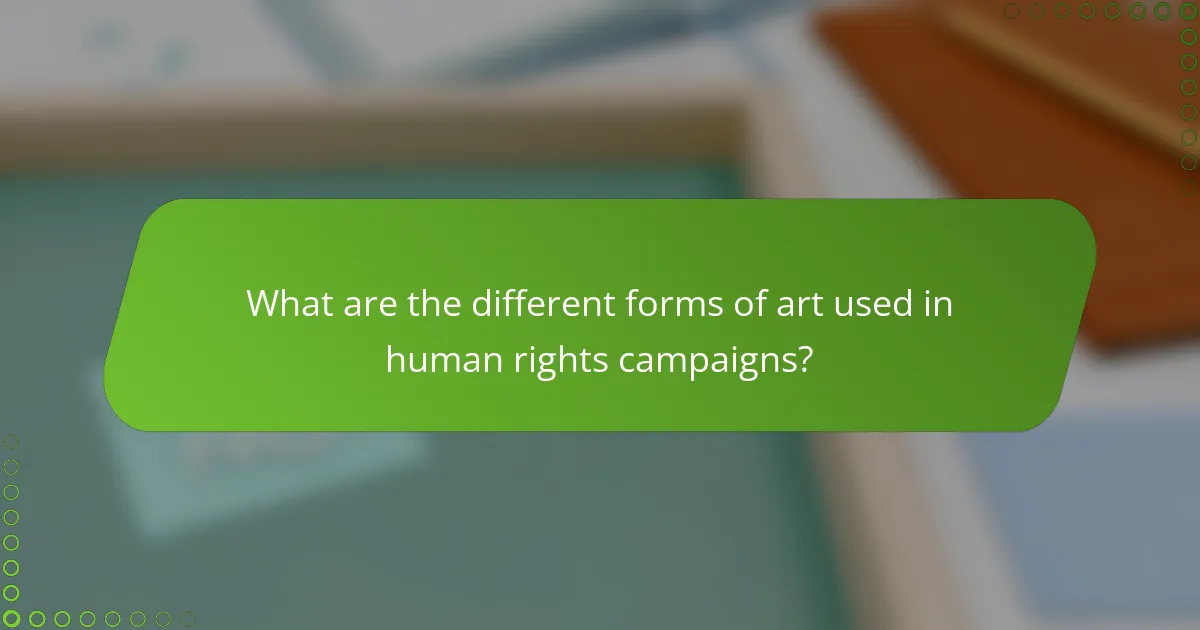
What are the different forms of art used in human rights campaigns?
Various forms of art are utilized in human rights campaigns. These include visual art, such as paintings and murals, which convey powerful messages. Performance art, including theater and dance, engages audiences emotionally. Music serves as a rallying cry, often used in protests and events. Literature, including poetry and essays, provides deep reflections on human experiences. Film and documentaries raise awareness through storytelling. Photography captures real-life struggles, evoking empathy. Each art form effectively communicates human rights issues, inspiring action and change.
What types of artistic mediums are most effective in conveying human rights messages?
Visual art, performance art, and literature are the most effective artistic mediums for conveying human rights messages. Visual art, including paintings and photography, captures attention and evokes emotional responses. For instance, the photography of Sebastião Salgado highlights the plight of marginalized communities. Performance art engages audiences through live storytelling, often creating a powerful connection to human rights issues. The works of artists like Ai Weiwei challenge governmental oppression and inspire activism. Literature, including poetry and novels, provides deep insights into human experiences and injustices. Works like “The Kite Runner” by Khaled Hosseini illustrate the impact of war on human rights. These mediums effectively communicate complex messages and foster empathy, driving social change.
How do visual arts contribute to human rights awareness?
Visual arts contribute to human rights awareness by creating powerful visual narratives that highlight injustices. These artworks often evoke emotional responses, prompting viewers to engage with critical social issues. For example, renowned artist Ai Weiwei uses installations to address government oppression and refugee crises. His works, such as “Sunflower Seeds,” symbolize mass production and the loss of individuality. Additionally, murals and street art serve as accessible forms of expression in public spaces. They communicate messages of resistance and solidarity in communities. Studies show that visual arts can increase empathy and understanding among diverse audiences. This engagement often leads to increased activism and support for human rights causes.
What role does performance art play in human rights activism?
Performance art serves as a powerful tool in human rights activism. It provides a visceral and emotional experience that can engage audiences on a deeper level. Through embodiment and expression, artists highlight social injustices and human rights violations. Performance art often challenges the status quo and provokes critical discussions. It can create a sense of urgency and inspire action among viewers. Historical examples include the work of artists like Marina Abramović, who has addressed themes of violence and trauma. Additionally, events like the “One Billion Rising” campaign use performance art to raise awareness of gender-based violence. These instances demonstrate how performance art can amplify marginalized voices and foster solidarity.
How does music influence human rights movements?
Music influences human rights movements by raising awareness and fostering solidarity. It serves as a powerful tool for expression and communication. Songs often convey messages of struggle, hope, and resistance. For example, “We Shall Overcome” became an anthem during the Civil Rights Movement in the United States. This song united people and inspired action against racial injustice. Additionally, music can mobilize communities and inspire protests. Artists like Bob Marley and Joan Baez have used their platforms to advocate for social change. Their music resonates with listeners and encourages activism. Studies show that music can enhance emotional connections to social issues. This connection motivates individuals to participate in movements.
What are some notable songs that have inspired human rights activism?
“Imagine” by John Lennon is a notable song that has inspired human rights activism. Released in 1971, it promotes peace and unity. The lyrics encourage listeners to envision a world without borders or conflict. “Redemption Song” by Bob Marley is another influential piece. It speaks to freedom and resistance against oppression. Its powerful message resonates with many social justice movements. “Fight the Power” by Public Enemy addresses systemic racism and inequality. This song became an anthem for the civil rights movement in the late 1980s. “Where Is the Love?” by The Black Eyed Peas raises awareness about global issues. Its lyrics question social injustices and promote compassion. Each of these songs has played a vital role in mobilizing people for human rights causes.
How can music serve as a tool for solidarity in human rights campaigns?
Music serves as a powerful tool for solidarity in human rights campaigns by uniting people around a common cause. It evokes emotions and fosters a sense of belonging among diverse groups. Historical examples, such as “We Shall Overcome,” played a significant role in the Civil Rights Movement, rallying support and inspiring action. Music also amplifies messages, making them more accessible and memorable. Studies indicate that songs associated with social movements can increase awareness and motivate participation. Furthermore, music events often raise funds and awareness for human rights causes, creating a tangible impact. Overall, music’s ability to connect individuals transcends barriers, making it an essential element in advocating for human rights.
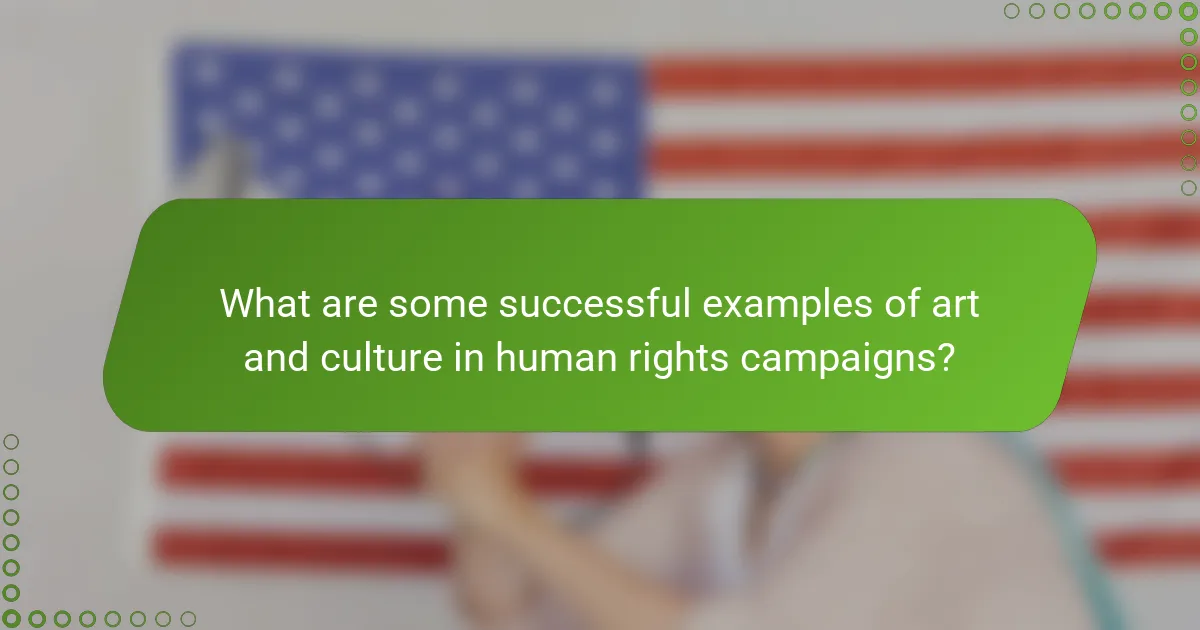
What are some successful examples of art and culture in human rights campaigns?
Successful examples of art and culture in human rights campaigns include the “AIDS Memorial Quilt.” This quilt raised awareness about the AIDS crisis and honored those who died. Another example is the “One Billion Rising” campaign. It used dance to raise awareness about violence against women. The “Human Rights Campaign” features art to promote [censured] rights. The “Free Nelson Mandela” campaign utilized music to mobilize support for his release. These campaigns demonstrate how art can effectively communicate human rights issues and inspire action.
What case studies highlight the effectiveness of art in human rights advocacy?
Art has proven effective in human rights advocacy through various case studies. One notable example is the “Art for Amnesty” campaign by Amnesty International. This initiative engages artists to create works that raise awareness about human rights issues. It has successfully mobilized public support for campaigns against torture and political imprisonment.
Another significant case study is the “One Million Bones” project. This project involved artists and activists creating handcrafted bones to raise awareness about genocide and mass atrocities. It culminated in a large-scale installation in Washington, D.C., which drew attention to these critical issues.
The “Street Art for Human Rights” movement also exemplifies art’s impact. Street artists worldwide have used their craft to highlight injustices and promote social change. Their work often sparks dialogue and raises awareness in communities.
These case studies demonstrate how art serves as a powerful tool for advocacy. They engage audiences emotionally and visually, making complex human rights issues more accessible.
How did specific artworks or performances create change in public policy?
Specific artworks and performances have significantly influenced public policy by raising awareness and prompting social change. For example, the AIDS Memorial Quilt brought attention to the AIDS crisis in the 1980s. Its display in public spaces mobilized communities and pushed for better healthcare policies. Similarly, the performance piece “The Vagina Monologues” highlighted issues of gender violence. This led to increased advocacy for women’s rights legislation. The documentary “13th” examined racial inequality in the United States. It spurred discussions that contributed to criminal justice reform initiatives. These examples illustrate how art can serve as a catalyst for policy changes by engaging the public and lawmakers on critical social issues.
What lessons can be learned from successful art-driven human rights initiatives?
Successful art-driven human rights initiatives demonstrate the power of emotional engagement. Art can evoke empathy and provoke thought, making complex issues accessible. Initiatives like the “AIDS Memorial Quilt” have raised awareness and humanized the impact of the AIDS crisis. Similarly, the “Street Art for Mankind” movement uses murals to address child slavery. These projects show that visual storytelling can mobilize communities and inspire action. Collaborative efforts between artists and activists amplify voices and foster solidarity. Engaging diverse audiences through art can lead to broader support for human rights causes. This approach highlights the importance of creativity in advocacy, making it a vital tool for change.
How can individuals and organizations leverage art and culture in their own campaigns?
Individuals and organizations can leverage art and culture in their campaigns by integrating creative expressions that resonate with their audience. Art can evoke emotions and provoke thought, making messages more memorable. Cultural references can enhance relatability and foster connection. For example, using visual art or performance can highlight social issues effectively. A study by the University of Southern California found that art-based campaigns increased public engagement by 30%. This evidence shows that art and culture can amplify the impact of human rights messages.
What strategies can be employed to incorporate art into human rights advocacy?
Art can be effectively incorporated into human rights advocacy through various strategies. Visual art can raise awareness by depicting human rights issues. Art installations can create immersive experiences that engage the public. Performance art can convey powerful messages through storytelling and emotional expression. Collaborations with artists can amplify advocacy campaigns. Social media can be used to share art that highlights human rights violations. Public exhibitions can provide platforms for dialogue and education. Community workshops can empower individuals to express their experiences through art. These strategies have been successfully employed in campaigns, such as the “Art for Amnesty” initiative, which showcases artists advocating for human rights globally.
What resources are available for artists interested in supporting human rights causes?
Artists can access various resources to support human rights causes. Organizations like Amnesty International provide toolkits and grants for artistic projects. The Creative Community for Peace offers resources and networking opportunities for artists. Additionally, platforms such as Art for Amnesty enable artists to sell work and donate proceeds. The United Nations also has initiatives that support artists in raising awareness. These resources empower artists to contribute meaningfully to human rights advocacy.
What best practices should be followed when using art and culture in human rights campaigns?
Utilizing art and culture in human rights campaigns requires specific best practices. First, ensure that the art is culturally relevant and resonates with the target audience. This fosters a deeper connection and understanding of the issues presented. Second, collaborate with local artists and communities to promote authenticity. Their insights can enhance the message and engagement.
Third, use diverse artistic mediums to reach various demographics. Visual art, music, theater, and literature can communicate messages uniquely and effectively. Fourth, maintain sensitivity to the subject matter. Respect for the experiences of marginalized groups is crucial in avoiding exploitation.
Fifth, create interactive experiences to engage audiences actively. This can include workshops, performances, or community discussions. Engaging audiences fosters empathy and encourages action. Lastly, measure the impact of the campaign through feedback and community involvement. This ensures continuous improvement and relevance in future initiatives.
The main entity of this article is the influence of art and culture in human rights campaigns. The article explores how artistic expressions, including visual art, music, and literature, shape public perception, foster empathy, and mobilize support for human rights advocacy. It highlights the roles artists play in raising awareness, the emotional impact of cultural narratives, and the effectiveness of various artistic mediums in conveying human rights messages. Additionally, it discusses successful case studies and best practices for integrating art into human rights initiatives, emphasizing the importance of emotional engagement and community collaboration in advocacy efforts.
